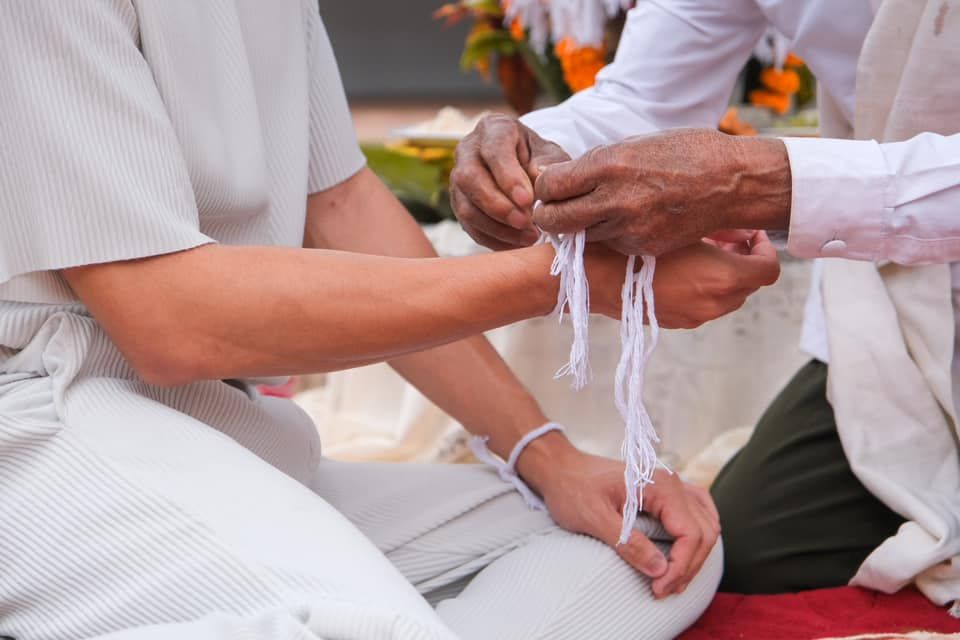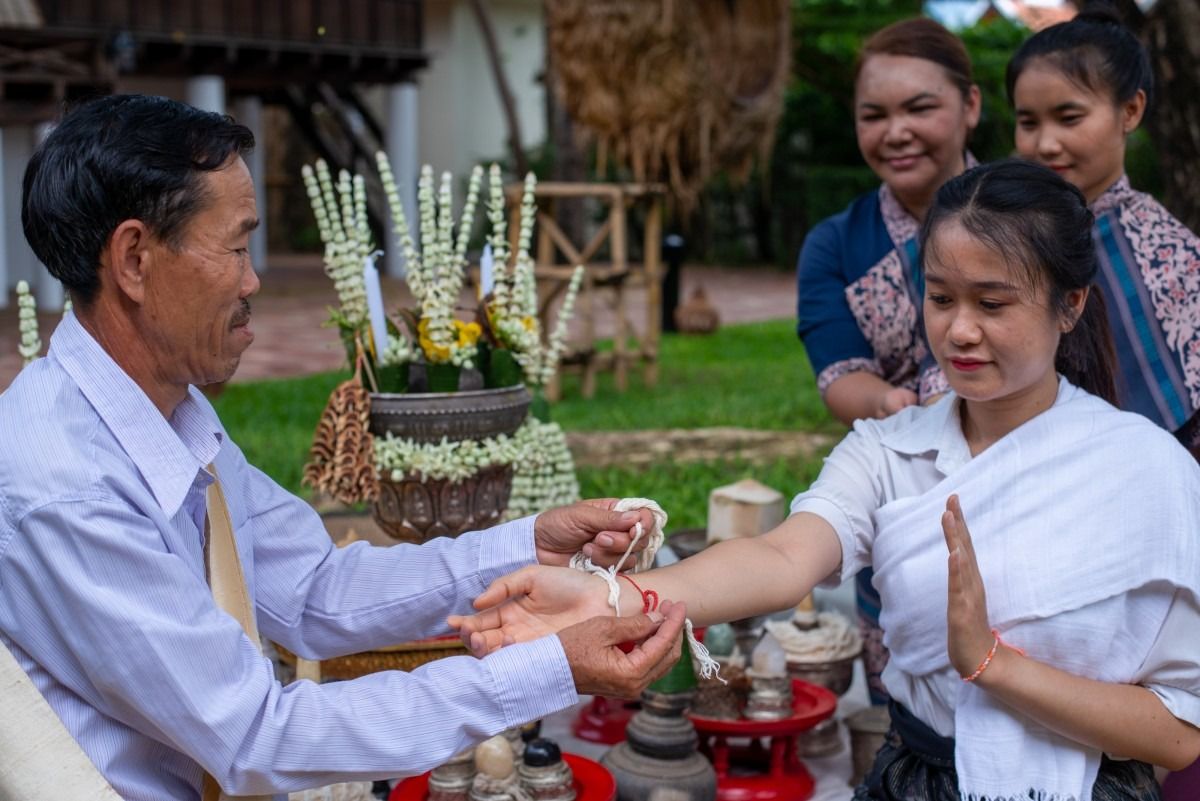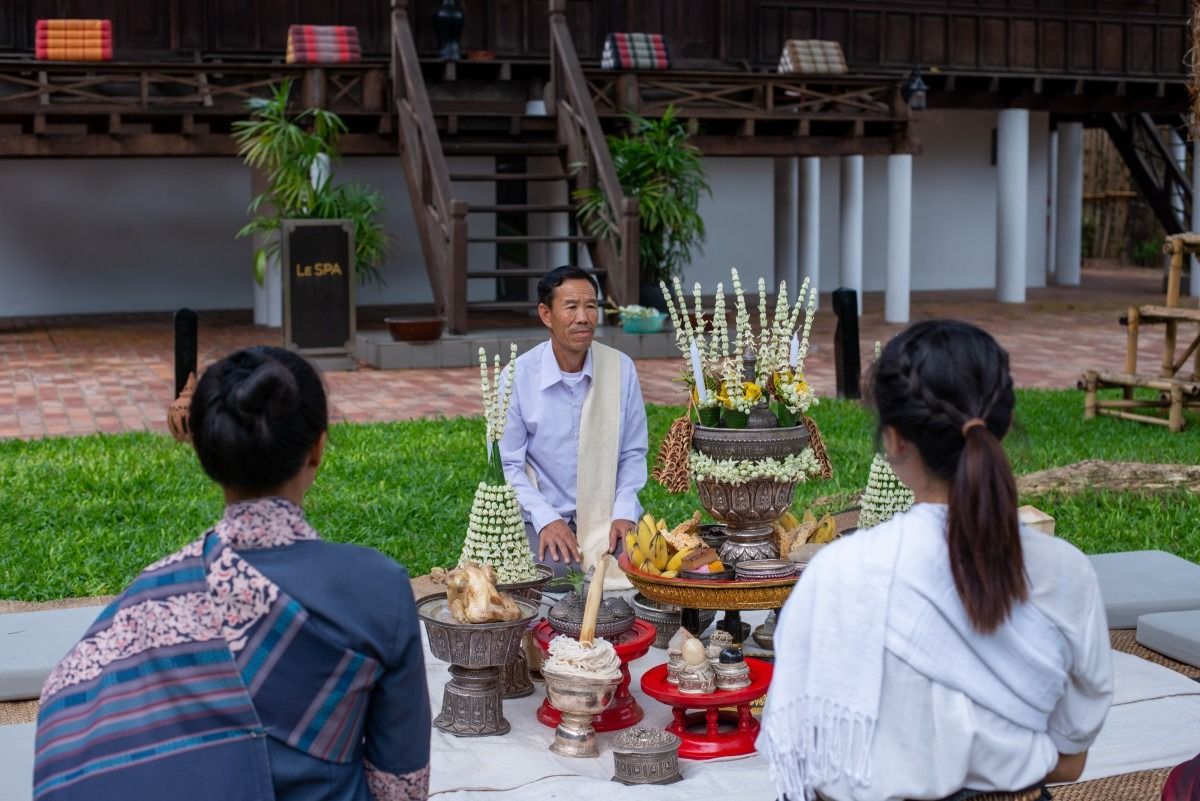Laos, a small country in Southeast Asia, is home to fascinating traditions that are passed down from generation to generation. At the heart of this cultural richness is Baci, a practice rooted in Buddhism for centuries.
Laos, a small country in Southeast Asia, is home to fascinating traditions that are passed down from generation to generation. At the heart of this cultural richness is Baci, also known as 'Sou Khuan', a practice rooted in Buddhism for centuries.
In this article, let's explore the world of Baci together, delve into its origins, learn about its development, and grasp the depth of its meaning. Get ready to discover the magic of this ritual.
1. What is Baci ceremony?
The term "Baci" in Lao translates literally to "tie." This ritual is rooted in the belief in the unity of 32 spiritual organs called 'khwan,' responsible for our happiness and well-being. According to Lao tradition, life events such as illness, accidents, family discord, or major changes can disrupt these organs, causing an imbalance in our spiritual well-being. The purpose of Baci is to restore this equilibrium by using symbolic white threads to re-establish the connection between these organs.

The term "Sou Khuan," combining "Sou" for soul and spirit; "Khuan" meaning "to tie," deeply signifies the Baci ceremony, understood as the "calling of the soul." Participants express their desires and prayers, considered commitments to the spirits, which will manifest due to their goodwill. This highlights the importance of nurturing one's soul, spirit, maintaining harmony with others, and nature.
Beyond its ceremonial aspects, Baci reinforces familial and friendly relationships, thereby preserving the essence of Lao culture. This ceremony provides a unique opportunity to reconnect with tradition, values, and roots, consolidating the cultural identity of Laos.
2. When does Baci ceremony occur?
The Baci ceremony is flexible concerning dates, with specific days considered more auspicious based on advice from elders, monks, or former priests. Apart from its ceremonial aspect, it is viewed as a therapeutic method, potentially alleviating stress, anxiety, and other mental health issues. It's conducted during special events like weddings, childbirth, welcoming guests, and Laotian New Year (Tet Lao), but also during tougher times like funerals or illnesses.

During festive occasions such as weddings, families gather for this ceremony. Participants, especially the elderly, tie white cotton threads around the wrists, recite prayers, and make wishes. During Tet Lao, the ceremony takes on a particularly celebratory tone, marked by joy and vibrant colors, wishing everyone a prosperous year.
However, the scope of this ritual transcends moments of happiness. It intervenes in cases of death or illness, providing spiritual support and comfort. Prayers and blessings aim to soothe the soul and promote healing.
3. How does the Baci ceremony go?
The Baci ceremony begins with setting up a sacred altar resembling a pyramid, adorned with flowers, candles, and offerings called "pha khuan." Placed in the center of the room, this pyramid comprises branches, leaves, and blossoms, symbolizing the tree of life.
Participants gather around this altar, forming a circle while holding hands, symbolizing unity and solidarity. Often attired in traditional costumes, they contribute to the festive ambiance of the event. The ceremony starts with earnest prayers, led by a revered spiritual leader in the community, encompassing invocations and blessings to summon spirits to join the ceremony, inspiring participants to connect with the spirits of nature.

The crux of the Baci lies in tying the white strings. These white bracelets, considered auspicious, are tied around the wrists of the participants. During this phase, everyone expresses wishes for themselves and others, thereby strengthening family bonds and friendships. These white bracelets are worn for three days before being cast into a river or stream to send wishes into the universe.
This ceremony, which could last several hours, is accompanied by traditional music and dances, culminating in a communal meal featuring local dishes like laap, tam mak hoong, or khao niaw, served with herbs and spicy sauce. More than just food, this meal signifies unity and community, offering travelers joyful and grateful moments, while honoring the richness of regional cuisine through intricately woven bamboo plates, providing an authentic experience
4. Practical advice when attending the Baci ceremony
4.1. Appropriate Attire
To participate in the Baci ceremony, dressing respectfully in line with Lao culture is essential. Men should wear long trousers paired with a shirt, while women can opt for long dresses or loose trousers with a shoulder-covering top. Outfits that are too short, tight, or revealing may be deemed inappropriate.
4.2. Recommended Items to Bring
Bringing ceremonial offerings is customary in the Baci ceremony. This might include fresh flowers, candles, incense, or even traditional Lao liquor like lao-lao. These offerings symbolize respect and gratitude towards the hosts of the ceremony. Ensure to check specific preferences or limitations with the organizers.

4.3. Engage in Bracelet Tying
An important step in the Baci involves tying fabric bracelets, considered as lucky charms. If interested, you can participate in this activity by requesting from the organizers, encouraging interaction and a positive contribution to the ceremony.
4.4. Do Not Cut Bracelets, Remove Them After Three Days
It's crucial not to cut the bracelets but to remove them after approximately three days. This practice respects the traditions of Laos. If you're unable to wear them during this period, remember to carefully remove and store them safely.